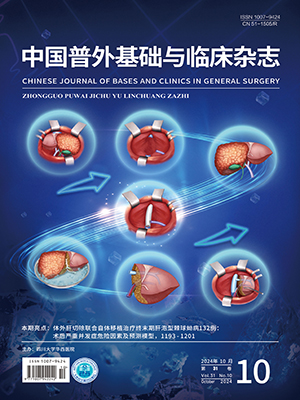| 1. |
Neal CD, John RL, Michael O著; 章士正译. 腹部影像检查答疑. 北京:人民卫生出版社, 2011:175-205.
|
| 2. |
潘雪琳, 李真林, 程巍, 等. 腹部低剂量CT技术的临床应用. 中国医疗设备, 2012, 27(6): 69-73.
|
| 3. |
李真林, 陈宪, 帅桃, 等. 多层螺旋CT一站式检查在胸腹部复合地震伤中的应用. 四川大学学报:医学版, 2011, 42(5):678-680.
|
| 4. |
Moore EE, Cogbill TH, Jurkovich GJ, et al. Organ injury scaling:spleen and liver (1994 revision). J Trauma, 1995, 38(3):323-324.
|
| 5. |
Kohn JS, Clark DE, Isler RJ, et al. Is computed tomographic grading of splenic injury useful in the nonsurgical management of blunt trauma?. J Trauma, 1994, 36(3):385-389.
|
| 6. |
Sutyak JP, Chiu WC, D'Amelio LF, et al. Computed tomography is inaccurate in estimating the severity of adult splenic injury. J Trauma, 1995, 39(3):514-518.
|
| 7. |
Marmery H, Shanmuganathan K, Alexander MT, et al. Optimiza-tion of selection for nonoperative management of blunt splenic injury:comparison of MDCT grading systems. Am J Roentgenol, 2007, 189(6):1421-1427.
|
| 8. |
Boscak A, Shanmuganathan K. Splenic trauma:what is new?. Radiol Clin North Am, 2012, 50(1):105-122.
|
| 9. |
Becker CD, Gal I, Baer HU, et al. Blunt hepatic trauma in adults:correlation of CT injury grading with outcome. Radiology, 1996, 201(1):215-220.
|
| 10. |
Cohn SM, Arango JI, Myers JG, et al. Computed tomography grading systems poorly predict the need for intervention after spleen and liver injuries. Am Surg, 2009, 75(2):133-139.
|
| 11. |
Velmahos GC, Tabbara M, Gross R, et al. Blunt pancreatoduodenal injury:a multicenter study of the Research Consortium of New England Centers for Trauma (ReCONECT). Arch Surg, 2009, 144(5):413-420.
|
| 12. |
Gupta A, Stuhlfaut JW, Fleming KW, et al. Blunt trauma of the pancreas and biliary tract:a multimodality imaging approach to diagnosis. Radiographics, 2004, 24(5):1381-1395.
|
| 13. |
Wong YC, Wang LJ, Lin BC, et al. CT grading of blunt pancreatic injuries:prediction of ductal disruption and surgical correlation.J Comput Assist Tomogr, 1997, 21(2):246-250.
|
| 14. |
Teh SH, Sheppard BC, Mullins RJ, et al. Diagnosis and management of blunt pancreatic ductal injury in the era of high-resolution computed axial tomography. Am J Surg, 2007, 193(5):641-643.
|
| 15. |
Wong YC, Wang LJ, Fang JF, et al. Multidetector-row computed tomography (CT) of blunt pancreatic injuries:can contrast-enhancedmultiphasic CT detect pancreatic duct injuries?. J Trauma, 2008, 64(3):666-672.
|
| 16. |
Soto JA, Alvarez O, Múnera F, et al. Traumatic disruption of the pancreatic duct:diagnosis with MR pancreatography. AJR Am J Roentgenol, 2001, 176(1):175-178.
|
| 17. |
Moore EE, Cogbill TH, Malangoni MA, et al. Organ injury scaling, Ⅱ:pancreas, duodenum, small bowel, colon, and rectum. J Trauma,1990, 30(11):1427-1429.
|
| 18. |
Stuhlfaut JW, Soto JA, Lucey BC, et al. Blunt abdominal trauma:performance of CT without oral contrast material. Radiology, 2004, 233(3):689-694.
|
| 19. |
Brofman N, Atri M, Hanson JM, et al. Evaluation of bowel and mesenteric blunt trauma with multidetector CT. Radiographics, 2006, 26(4):1119-1131.
|
| 20. |
Hamilton P, Rizoli S, McLellan B, et al. Significance of intra-abdo-minal extraluminal air detected by CT scan in blunt abdominal trauma. J Trauma, 1995, 39(2):331-333.
|
| 21. |
Malhotra AK, Fabian TC, Katsis SB, et al. Blunt bowel and mesen-teric injuries:the role of screening computed tomography. J Trauma,2000, 48(6):991-1000.
|
| 22. |
Mirvis SE, Shanmuganathan K, Erb R. Diffuse small-bowel ischemia in hypotensive adults after blunt trauma (shock bowel):CT findings and clinical significance. AJR Am J Roentgenol, 1994, 163(6):1375-1379.
|




